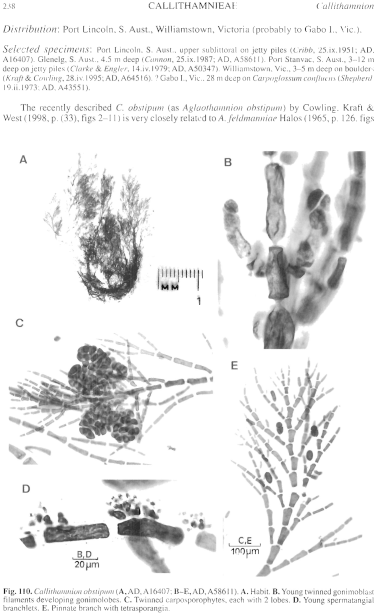|
|
|
|
|
|||||||||||
|
Electronic Flora of South Australia Species Fact Sheet
Phylum Rhodophyta – Order Ceramiales – Family Ceramiaceae – Tribe Callithamnieae
Synonym
Aglaothamnion obstipum Cowling, Kraft & West 1998: 33, figs 2–11.
Thallus (Fig. 110A) erect, medium red-brown, 1–2 cm high, distichously branched (Fig. 110E), with laterals for 2–3 orders, ecorticate throughout except for loose rhizoidal cortication over lowest few cells. Branchlets markedly slenderer than parent axes. Attachment by a rhizoidal holdfast; epilithic or on jetty piles. Structure. Lower axes 160–250 µm in diameter, cells with a thick wall, L/D 1–1.5 (–2); lateral branchlets prominently alternately distichous with ultimate filaments 6–14 cells long and unbranched, usually with an abaxial branch from the basal cell, lower cells 40–55 µm in diameter and L/D 2–3, tapering to 18–30 µm in diameter and L/D 2–3 at 3–4 cells below apices, then to smaller apical cells with rounded ends. Cells uninucleate; rhodoplasts discoid, ribbon-like in older cells and longitudinally aligned.
Reproduction: Gametophytes dioecious. Procarps borne on axial cells, with two periaxial cells one of which (the supporting cell) bears the 4-celled carpogonial branch; post-fertilization each periaxial cell cuts off an auxiliary cell (Fig. 110B) and 1 or 2 rounded lobes (Fig. 110C) 90–180 µm across of carposporangia 15–25 µm across; a loose involucre of branched filaments develops from 1 or 2 cells below the carposporophyte. Spermatangia (Fig. 110D) on small clusters on ultimate branches, 1–3 per parent cell, branched 2–3 times, spermatangia ovoid, 2–3 µm in diameter.
Tetrasporangia (Fig. 110E) sessile and adaxial on lower cells of the ultimate branchlets, ovoid, 35–55 µm in diameter, sub-decussately to tetrahedrally divided.
Type from Gloucester Reserve, Williamstown, Vic. on Mesophyllum, 3–5 m deep (Kraft & Saunders, 3.iii.1995); holotype in MELU, K10543.
Selected specimens: Port Lincoln, S. Aust., upper sublittoral on jetty piles (Cribb, 25.ix.1951; AD, A16407). Glenelg, S. Aust., 4.5 m deep (Cannon, 25.ix.1987; AD, A58611). Port Stanvac, S. Aust., 3–12 m deep on jetty piles (Clarke & Engler, 14.iv.1979; AD, A50347). Williamstown, Vic., 3–5 m deep on boulders (Kraft & Cowling, 28.iv.1995; AD, A64516). ? Gabo I., Vic., 28 m deep on Carpoglossum confluens (Shepherd, 19.ii.1973; AD, A43551).
Distribution: Port Lincoln, S. Aust., Williamstown, Victoria (probably to Gabo I., Vic.).
Taxonomic notes: The recently described C. obstipum (as Aglaothamnion obstipum) by Cowling, Kraft & West (1998, p. (33), figs 2–11) is very closely related to A. feldmanniae Halos (1965, p. 126, figs 4–6), and may be within the variability of the latter. A. obstipum was considered to differ from A. feldmanniae in habit, in having prostrate axes, an abaxial branchlet on the basal cell of laterals, and in having tetrasporangia often borne in pairs on parent cells, as well as being characterised by flexing of the bearing cells of the spermatangial clusters. A. obstipum does appear to be a more robust species, with apical cells 10–16 µm in diameter, lower cells of laterals 22–45 µm in diameter, and mid to lower cells of main axes 55–120 µm in diameter, compared to 8–10 µm, 15–40 µm and 60–110 µm respectively in A. feldmanniae (as in Maggs & Hommersand 1993, p. 97 and slide from Milford Haven, Wales (AD, A67791, sent by C. Maggs).
The basal attachment may provide a minor difference, but the presence or not of an abaxial basal branch on the laterals and in pairing of tetrasporangia is variable in both species. The flexing of cells bearing spermatangial clusters seen in culture does not occur in the single field collection (AD, A58611 - see Fig. 110D) and may be unimportant.
For the moment, A. obstipum is used rather than A. feldmanniae, but further collections and comparisons are clearly desirable.
References:
HALOS, M.T. (1965). Sur trois Callithamniées des environs de Roscoff. Cah. Biol. mar 6, 117–134.
MAGGS, C.A. & HOMMERSAND, M.H. (1993). Seaweeds of the British Isles. Vol. 1. Rhodophyta. Part 3A, Ceramiales. (HMSO: London.)
The Marine Benthic Flora of Southern Australia Part IIIC complete list of references.
Publication:
Womersley, H.B.S. (24 December, 1998)
The Marine Benthic Flora of Southern Australia
Rhodophyta. Part IIIC. Ceramiales – Ceramiaceae, Dasyaceae
©State Herbarium of South Australia, Government of South Australia
Illustration in Womersley Part IIIA, 1998: FIG. 110.

Figure 110 enlarge
Fig. 110. Callithamnion obstipum (A, AD, A 16407; B–E, AD, A58611). A. Habit. B. Young twinned gonimoblast filaments developing gonimolobes. C. Twinned carposporophytes, each with 2 lobes. D. Young spermatangial branchlets. E. Pinnate branch with tetrasporangia.

|
Email Contact: State Herbarium of South Australia |

|